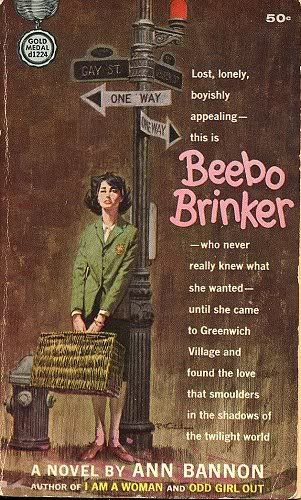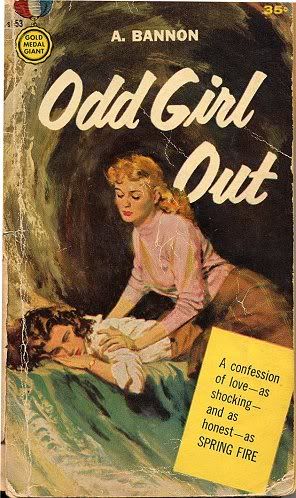
Ann Bannon is without doubt the best-known and most respected of the vintage lesbian pulp authors. Born Ann Welby in 1932, Ann Bannon was raised in Joliet, Illinois. Introduced to the works of Ann Aldrich (writing as Vin Packer) and Radclyffe Hall while still in college, Bannon used these writers as her inspiration and - integrating observations which she had made about her two college roommates - authored her first novel, Odd Girl Out (1957). Having married after graduation, Ann’s husband forbade her from using his surname on her writing, leading her to choose the pen name of Bannon. After giving birth to two daughters, Bannon earned her Ph.D in linguistics at Stanford, before divorcing and moving to California, where between 1959 and 1962 she wrote her next five (and best remembered) novels.
Unlike the tackier lesbian themed paperbacks which were being ground out to satiate a mostly male audience, Bannon’s novels are regarded as an accurate and insightful depiction of lesbian life during this period of social and sexual repression (although the cover art and photographs designed by the publishers made no attempt to illustrate this fact). Carrying the lives of her major characters over from one novel to the next, Bannon created fully-developed and refined characters, who exist within plausible story lines.
Of Bannon’s lesbian works, Beebo Brinker is the best known, and is something of a prequel to her other works, establishing the popular character featured in her earlier books. Published by Gold Medal in 1962, it tells of Beebo at age eighteen, arriving in Greenwich Village fresh off the farm, her worldly possessions inside an old wicker suitcase, a worn old copy of the Guide to Greenwich Village clutched in her hand. Stuck firmly in the closet for the first third of the book’s narrative, before finally coming out to her gay roommate Jack. From there, Beebo quickly makes the transition from shy farm girl to dominating butch, falling into bed with Mona, then Paula, before finally getting snared by Venus, a glamorous film star.
Her final novel for Gold Medal, Beebo Brinker was originally issued with a cover painting which plainly illustrated the publisher and artist’s misconception of (or total disregard for) the content of the book. Conceived by Bannon as ’tall, strong, handsome and blue-jeaned ‘, she is presented on the cover (by Robert McGinnis) as a nerdy, private school girl type, standing under a sign subtlety marked ‘Gay Street’ (and in case we miss the point, another street sign above her head reads ‘One Way’. The cover blurb boldly proclaims:
Lost, Lonely, boyishly appealing - this is Beebo Brinker - who never really knew what she wanted, until she came to Greenwich Village and found the love that smoulders in the shadows of the twilight world.
In 1984, Bannon appeared in Robert Rosenberg’s documentary film Before Stonewall, which chronicled the history of the Gay and Lesbian community before the Stonewall riots began the major gay rights movement. Two years later, her early paperbacks were re-issued by Naiad Press, a Florida based publisher who specialised in lesbian works. This time around, the covers used a very simplistic, blue silhouette design, which helped shift the emphasis away from the vicarious exterior and onto the content, earning Bannon her due recognition as a pioneer of lesbian fiction, and establishing Beebo Brinker as a gay icon of her times.
Ann Bannon: Selected Bibliography
Gold Medal:
Odd Girl Out (1957)
I Am A Woman (1959)
Women In The Shadows (1959)
Journey To A Woman (1959)
The Marriage (1960)
Beebo Brinker (1962)
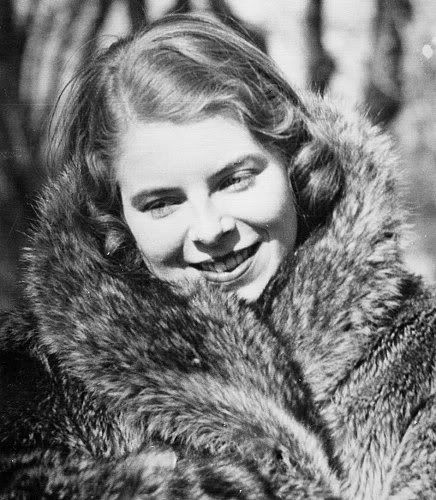
INTERVIEW: ANN BANNON
Ann, can you tell me a little about your childhood and growing up in Joliet, Illinois? What sort of place was it at the time, and how do you think it influenced your later writings?
Actually, while I was born in Joliet, I grew up in Hinsdale, Illinois. It was small and beautiful, a suburb of Chicago that almost looks today like a museum of handsome old Victorian homes deployed on acres of emerald lawns. My family started out with substantial resources and ended up with almost nothing, so I experienced the town from a variety of perspectives, some of them painful. I always felt profoundly different from the other kids--and indeed, was--but found ways to look, talk, dress, and act like the rest. It was a survival strategy, which gave me a secure cover, but always made me feel like a spy among my age-mates.
How did you first approach Gold Medal with your idea for your first paperback? Was it a cold submission of a freelance manuscript, or did you sell them initially on a synopsis?
Luck was with me on this one. I should be able to tell you that I struggled for years and papered my bathroom walls with rejection slips. But in fact, I had initiated a correspondence with Marijane Meaker, who was writing lesbian pulps for Gold Medal Books at the time under the pen names of Vin Packer and Ann Aldrich. Somehow, we hit it off in the correspondence. I was newly married, living in Philadelphia then, and when she learned I had a manuscript, Marijane invited me to New York to meet her editor at Gold Medal--Dick Carroll. I took with me an overwritten and overwrought manuscript about 650 pages long. Dick read it over a two- or three-day period, out of friendship for Marijane, I'm sure. He gave me good advice: "Cut the length in half, and focus on the two young women. That's your story." I was abashed, but went home and did as he said. It became Odd Girl Out, my first novel, and Gold Medal published it without changing a word. Talk about luck! Carroll told me he received 400 unsolicited manuscripts a month, and couldn't possibly do justice to them all.
Were you ever approached by any of the sleazier publishers to write lesbian books for them, or did you ever consider working within this field?
None of the sleaze folk ever came courting, probably because I was doing so well at Gold Medal and they just figured I couldn't be pried loose--which was in fact the case. I was always grateful to Dick Carroll, and to Knox Burger, who succeeded him, for taking good care of me and the Beebo Brinker Chronicles. And Of course I had no way of knowing back then that my books would develop a life of their own far into the future.
What was your opinion of the more lurid lesbian paperbacks? Did you ever read any of them, or did you make a concerted effort to distance yourself - and your own work - from them?
I thought some of them were kind of fun and intriguing--sort of a romp through as many bedrooms and sexual configurations as the readers' short memory span could endure. But there were many others that were dripping with misogyny and homophobia, and those I gave a wide berth. I never really tried to emulate either genre, since I always believed I was writing lesbian love stories, not sleaze per se.
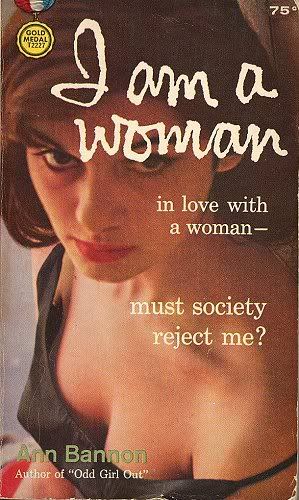
Was there much editing/rewriting done on the manuscripts by the publisher? If so, were you given a final draft of the novel to approve prior to publication, or was it pretty much out of your hands once the completed work had been handed over?
After I submitted a completed draft, it would take a couple of months before I heard back from Gold Medal. But were they busy editing and rewriting? Mercifully, no. They did almost none of that. (Perhaps they should have!) Now and then they would scold me for trying to use a phrase like "shit list." It's one of the few they told me to change. When I balked, I discovered they had done it themselves, and it came out "black list." Those were the days of the post-Victorian era in publishing! We thought we were pretty cutting-edge, but we were still pretty bound by tradition and convention--in print, anyway.
After a couple of months, I would get the galley proofs in the mail, read through them for errors, and return them to Gold Medal. I think I made relatively few changes myself. I was usually into the next book when the preceding one was in production, so my imagination had already flown ahead to new ideas and events.
Ann, I understand that when you completed Odd Girl Out, your husband at the time forbade you from using his surname on the book, which led you to create the Bannon pseudonym. How did this make you feel? Did it have a big impact on your relationship, and was their any major factor which led to you choosing the name Bannon?
My husband at the time I was writing didn't so much forbid me to use his name as he expressed dismay at the possibility of seeing it splashed all over a semi-draped bosom on the cover of a pulp paperback novel. Despite a few chuckles at the prospect, I knew he meant it. But that was fine with me--I had no wish to be an embarrassment to his family or to my own. I was both afraid that what I was writing would never find an audience, and afraid that it would. I didn't want to fail, but I didn't want to become a pariah among family and friends for writing on such a controversial subject, either. And it was very difficult for me to judge my own work. Was it good enough to hold a readership? I honestly didn't know till Odd Girl Out was published and became a hit. By then, Of course, I had chosen the pen name of Ann Bannon. It actually came from a list of prospective clients my husband, then a salesman, had left lying on the desk one day. I liked it because it's Irish, like a lot of my family, and it encapsulates my own first name. (Whether my ex ever sold anything to the Bannon family, I never knew!)
Do you recall where you got the inspiration for the Beebo Brinker character? You introduced her in your early novels, before expanding upon her in her own book in 1962. Did you decide to write Beebo Brinker because of reader feedback, or was she your favourite character whom you wished to give a bigger picture of?
Beebo was floating around in my head for years before I ever dreamed of writing a book, much less a book about her. She was always big, assertive, handsome, self-confident, and BUTCH! And in my daydreams, she looked, as I've said elsewhere, like a cross between Ingrid Bergman in "For Whom the Bell Tolls" and Johnny Weismuller in his Tarzan drag. There were some qualities in some of the young women I knew--high school and college friends at that point--that Beebo shares. But no single individual quite lived up to all of the fantasies I projected onto the character. By the time I wrote her into her own book, Beebo Brinker, she had matured in my imagination, even while I was taking up the story line of her younger years. I did the book mainly because I wanted to tell that tale, but it wouldn't be fair not to acknowledge the interest that fans had shown in Beebo. In fact, that novel was the only one Gold Medal let me specify the title for, and they did it because they knew I had enough readers who would recognize the name.
In your forward to Strange Sisters, you tell a wonderful anecdote about the cover art for your novels, and the trepidation you would feel when unwrapping the package which contained copies of the published novel, dreading what kind of cover art they had dreamed up this time....
I got lucky here, too. Three of the books were adorned with photos, only one of which was really effective (I Am A Woman, with a sultry brunette gazing provocatively up at the reader). Mostly they were fairly innocuous. But Odd Girl Out shows Beth and Laura and the famous backrub scene. Actually, the original cover was redone when I complained that it looked so 1930s, no-one would be interested in it. I was wrong, fortunately, but Gold Medal got Barye Phillips, the artist, to rethink his first effort and redo it. The ladies come out looking much more Glamour Girl Fifties than Boarding School Thirties in the second version. When Beebo Brinker was in production, Gold Medal switched back to a painted cover. It was done by Robert McGinnis, who was a better artist, in my view, than Barye Phillips. But oh! what he did to Beebo is a crime. He obviously hadn't the faintest clue what to make of a lesbian hero, so he made her look like a Cosmo cover girl, with a trendy flip hairdo and makeup. But somebody must have told him (in a stage whisper, I presume), "She's a dyke!" So he put her in men's brogans. But as an afterthought, he added pink bobby sox. And to perfect the scene, he posed her under a street sign in Greenwich Village that says "Gay Street--One Way." Talk about heavy-handed symbolism! At least I was spared some of the more lurid covers, many of which promised more than the text inside them could deliver.
Looking back, what is your reaction to the covers of your early books, given that some people collect them primarily for the artwork? Did you have any input into the cover art when Cleis Press recently re-issued several of your books?
I've never had much input into covers, alas. Gold Medal never consulted me at all. Books just arrived in their plain brown wrappers, and you had to hold your breath and cross your fingers that what you were about to behold would not give you dyspepsia or scare the horses. Naiad Press simply made silhouettes of several of Tee Corrinne's photos, not all of which translated well into that mode. (Interestingly, however, the Naiad cover for Beebo Brinker is pretty good, since the original photo had sufficient outline detail to make the resulting silhouette forceful and readable.) Cleis Press has done a brilliant job of retrieving some of the 50s and 60s covers that are now out of copyright, and re-using them on my books. I've liked them all so far, although the Odd Girl Out cover is a shade less successful. Again, they didn't consult me first, but once I realized how they were proceeding, I did ask them to consider several old covers I really like for the forthcoming edition of Journey to a Woman. The reproductions and the brilliant background colors have made these jackets among the best and most eye-catching of all my editions. Incidentally, when the Quality Paperback Book Club brought out an omnibus edition of four of my books in the 90s, they simply reproduced the original Odd Girl Out cover on their version.
Considering that I had a quite sheltered upbringing in many ways, and was influenced by a genuine Victorian (my grandmother), I tend to present a rather formal front. It would have been disorienting to find myself, even via my nom de plume, associated with some of the more lurid cover art. I recognize, however, that it is fascinating stuff to collect, and have attended Vintage Pulp Paperback Book Shows where for many people, it's the main attraction.
How high a profile did these books bring you? Did you ever have any correspondence from readers forwarded onto you by the publisher?
The books gave me an incredible following--something I really never anticipated. I heard from hundreds of women all over the country--thousands, actually. Many of them were isolated, scared, ashamed, and convinced that there were no other human beings on the planet who shared their feelings. I had no idea how much angst there was out there. For a few years, when the books were current, the mailman used to stagger up the walk with bags of letters for me, all forwarded from Gold Medal. I tried conscientiously to answer them all--some better than others--with the message that the writers were not alone, that there was hope, that above all, there were others and not to give way to despair. I kept those letters for many years, until, during one of many moves we made during my married life, they were lost. I greatly regret the loss and wish now that I had them back. They would make eye-opening reading for young members of the gay community, and for others wondering what it's like to be in a marginalized group.
In the 50s and 60s, when I was first writing, we were deep into the era of Senator McCarthy and the House Un-American Activities Committee. It was a scary time to hold contrary political views, much less to discover that you were a sexually contrary being. I think if I had ended my marriage early on and struck out on my own as a writer, I'd have had a rewarding career and a much higher public profile than I had. But by the time I began to realize that my books had taken hold on the public imagination, I was a mother of two little children, and I had to put them first. The real notoriety didn't begin until the Naiad re-issues in the early 1980s, and it has built steadily from there.

What was the media reaction and coverage like for your books? Were they favourably reviewed, or was there any backlash against them because of the content? Were you contacted by the media for interviews and promotions, etc?
Wow--WHAT media reaction!? Those of us writing pulp fiction were distinctly infra dig in those days. No matter what your topic or how seriously or genuinely presented, if you were in paper covers, you were writing sleaze. And you sailed along well below the critical radar screen. No self-respecting literary critic would have stooped to reviewing a paperback novel. We had to wait for the Beatles to come along and write a song about us before people began to think it was a glamorous profession. Some of us resented being so utterly ignored by the literary establishment. But in retrospect, there was a silver lining: we were allowed to say pretty much what we wanted to say, to explore topics that very few others, and certainly even fewer "respectable" writers, were exploring, and to open new ground and new topics to the world of fiction. It's interesting to speculate what might have happened to us if we had shown up on the pages of the New York Times Book Review, only to be reviled and subjected to the castigation of the fundamentalist right. It might have set back avant-garde fiction by decades! So our relative anonymity served the purpose of keeping a dangerous backlash at bay. There were rumblings against some of us, but I was never targeted, as far as I know--unless, that is, the F.B.I. was keeping a file on me back then! I wasn't contacted for interviews, but it's of some interest that Gold Medal at least made an effort (unsuccessful) to sell some of my books to the movies. And I was certainly contacted by organizations like the Mattachine Society and the Daughters of Bilitis, to whom I occasionally spoke.
Nowadays, as you can imagine, things have changed a lot. Everybody wants an interview, and I can hardly keep up with invitations to lecture around the country. How times have changed!
What sort of publicity push did the publisher give your book, and other books in the genre? Was there much advertising and promotion, or did they let the books (in particular, the cover art and sensationalistic blurbs) pretty much sell themselves?
I used to see ads for my books in magazines that were part of the Gold Medal empire, such as fan magazines and the like. Gold Medal never alerted me that they were going to do it--I had to pick up one of the fanzines, usually by sheer accident, at a bookstall somewhere. But they, and most of the big, successful paperback publishers, were adroit marketers. They saw to it that these books were plentifully available in every sort of commercial and public gathering place where a simple shelf or kiosk could be set up. They made a fortune with them, simply distributing them to drugstores, bus stations, train terminals, airports, newsstands, and anywhere else people could walk in and casually pick up something to read. They were distributed in the hundreds of thousands. I remember Dick Carroll telling me at the time that he considered sales of about 200,000 for a given title to be solidly profitable. This is an amazing number. Ten thousand copies of a hard-cover book will usually break you even or better financially.
As for letting the covers and the blurbs sell the books, they did a handsome job of that. The women were always depicted as flirty, sexy, very femmy, very beautiful, often in their undies, often shooting one another smouldering looks. Men loved them and lapped them up. Women learned to read those covers iconically, as stories with a lesbian content, and stripped the kiosks bare. I didn't know it back then, but I had, in effect, caught a wave: the post WWII generation, pre-Women's Movement, pre-Stonewall and Civil Rights Movements, when people were just beginning to snap the bonds of sexual convention and delve into innovative relationships. It was a lucky confluence of social momentum and a young writer's need to challenge custom.
I read somewhere that in the early-1990s you were working on a new book which would examine the mature Beebo Brinker's life. Did you ever complete this book?
There's a manuscript on the shelf above my desk as I write this, looking at me reproachfully. People are asking me the same question all the time, and I'm running out of excuses! Yes, there's a book, and yes, it needs a great deal of rewriting before it deserves to be unveiled publicly. And yes once more, it's about Beebo. After all, she's still a handsome woman, still kicking butt, and still interesting to read about. Not many people have tackled love among the elders, and I'd like to give it a try. It was one of my sources of pride that I wrote about black-on-white romance in the 50s, about gay men and lesbians getting together and/or marrying when they wanted to have a child, about problems with domestic abuse, that almost nobody else was trying to examine back then. So why not take on a woman in her later years, still beautiful, still funny, still sexy, and let her show her stuff? But--it will be a while before I can clear the decks to get to it--probably early next year. Till then, I'm booked pretty solid on the lecture, interview, and writing circuits.
When did you first start to realise that your books were being admired and collected by a new generation of readers? Was it when Naiad Press re-issued them in the mid-1980s?
It was in the mid-80s, when the Naiad editions were doing so well, that it began to sink in. I had never thought that my books would have more of a lifespan than most other original paperbacks...which is to say, not much longer than six to eight months after they're published. I thought mine had gone to that Great Paper Shredder in the Sky by the early 1960s. To my astonishment, the New York Times came calling in the early 70s and asked to include them in a hardcover series they were planning to publish through their subsidiary, Arno Press, called Homosexuality: Lesbians and Gay Men in Society, History, and Literature (New York, 1975). Then, in 1981, I heard from Barbara Grier of Naiad Press, and we were off and running yet again. I owe Barbara and her partner, Donna McBride, a debt of gratitude for their faith in the books. And because they were the largest and most successful lesbian publishing house of their day, their edition made a huge impact. We did a promotional tour and I made a couple of documentaries as a result: Before Stonewall, and Forbidden Love. It was a lot of fun, and I thought I had had an incredible run of good luck. But then the aforementioned Quality Paperback Book Club edition came out, and following that, Cleis Press wanted to do a new edition. By this time, I think I am well and truly convinced that people have cared about and enjoyed these books through several generations of readers. Perhaps it's the social history they capture and reflect for younger readers interested in the gay and lesbian past. Perhaps it's their role as ground-breaking fiction in a repressive era. But more likely, it's the sheer emotional punch of the characters themselves. Christopher Nealon, who has written an interesting study of the pulps in his book Foundlings (Duke University Press, 2001), points out that the transcendent emotion evinced by characters in the lesbian paperbacks was a sort of heroic defense against the homophobia of the times. I think he hits it dead on. And it was certainly a compelling feature of these stories that grabbed readers and held on to them.
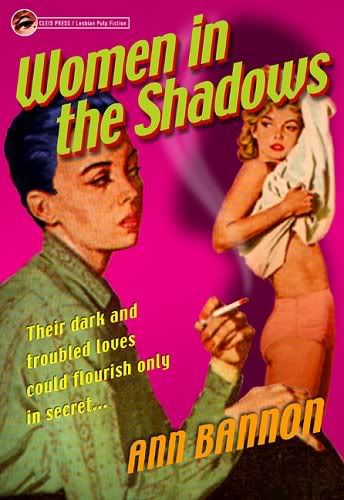
How do you feel about the attention which your books attract today? Do you enjoy meeting collectors at the paperback shows? Do you find that it's one particular type of person who approach you at these shows, or is it a real across-the-board audience?
It has been a lot of fun, not to mention an interesting revelation, to meet people at the Vintage Paperback Shows. An amazing variety of collectors show up, and they seem to enjoy collecting every conceivable genre of story. I was intrigued the first year I attended to find that one of the exhibitors had arranged his books in big cartons, all labeled by type. He had "Romance," "Science Fiction," "Detectives," "Westerns," "Mysteries," etc., and one irresistible category labelled "Sleaze." The next year he had added "Super Sleaze" and "Extreme Sleaze," This year came the capper: he had a new box labelled (you guessed it) "Beyond Sleaze." Fortunately, Beebo and the gang were only in the "Sleaze" box, although I had hoped to find them in "Romance." But that was before I realized that "Romance" was for dopey tales like The Cottage by the Sea and Little Women. Beebo would never have fit in. If by some mischance she had got herself stuck there, she would have dragged all those saccharine ladies back with her to the "Sleaze" box in short order. At these shows, I usually sit at a table with the likes of Forrest Ackerman, Ray Bradbury, or some of the famous cover illustrators, and enjoy two hours of chatting with fans and collectors of every stripe, from sweet old ladies to leather men to young families with kids. It's really surprising to discover how many people have been bitten by the paperback collecting bug and come to trade and play at the shows. I've enjoyed the contact, learned a lot, and bought a few books to keep for myself.
As for the attention my books are getting now, I'm delighted and a little overwhelmed by it--surprised, grateful, and still wondering what the girl I was all those years ago would have made of it, if there had been any way for her to peer into the future. It's an extraordinary validation of the lives and loves of the women I was writing about, and even of the pulp medium itself. How good to know, after all these years, that our once-scorned genre was capable of producing works with staying power and enduring interest for succeeding generations of readers.
Copyright John Harrison 2009
(Note: the above is a modified piece from my Headpress book Hip Pocket Sleaze).

